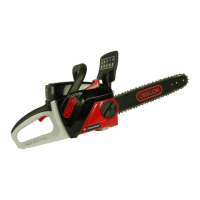26
OREGON® CORDLESS TOOL SYSTEM
CHAIN SAW MODEL CS250
MAINTENANCE AND CLEANING
AF 0513 F/N 547361
REPLACING THE
SHARPENING STONE
CAUTION: REPLACE
POWERSHARP® SAW CHAIN AND
THE SHARPENING STONE AT THE
SAME TIME. FAILURE TO DO SO
COULD RESULT IN DECREASED
PERFORMANCE OR DAMAGE TO
THE CHAIN AND/OR SHARPENING
STONE.
IMPORTANT: THE POWERSHARP®
INTEGRATED SHARPENING
SYSTEM IS FOR USE ONLY WITH
POWERSHARP® CHAIN.
With the chain saw off and cool and the
battery pack removed, remove the side
cover by removing the side cover knob.
Install the new sharpening stone as
follows:
• Remove the two screws holding the
sharpening stone. Remove the stone
(Fig. ).
• Make sure the PowerSharp® lever and
surrounding area are free of debris.
• Place the new stone in place. Replace
the screws and tighten snugly.
• Reinstall side cover and tighten the side
cover knob.
CLEANING THE SAW
CAUTION: WHEN CLEANING THE
CHAIN SAW POWER HEAD, DO NOT
IMMERSE IN WATER OR OTHER
LIQUIDS.
• Remove battery pack before cleaning.
• Remove wood chips and other debris
from the battery port. Make sure the
contacts are clean and dry.
• After use, clean debris from the chain
and guide bar. Wipe power head with a
clean cloth moistened with a mild soap
solution. Never use harsh cleaners or
solvents.
• Always clean out wood chips, saw dust,
and dirt from the bar groove when
replacing the saw chain.
BATTERY PACK
WARNING: THERE ARE NO
USER SERVICEABLE PARTS INSIDE
THE BATTERY PACK. DO NOT
DISASSEMBLE.
Lithium ion batteries have a finite
operating life. If the amount of cutting
time per charge decreases noticeably, the
battery pack is at the end of its useful life
and should be replaced.
• Make sure the battery pack, including
the contacts, is clean, dry, and has no
signs of puncture, impact, or other
damage. Broken batteries can cause
fires or emit hazardous chemicals.
• Clean dirty contacts with a soft, dry
cloth. Dirt or oil can cause a poor
electrical connection, resulting in loss of
power.
CHARGER
• Unplug the charger from the electrical
outlet.
• Clean dirty contacts with a soft, dry
cloth.
FIG. 31

